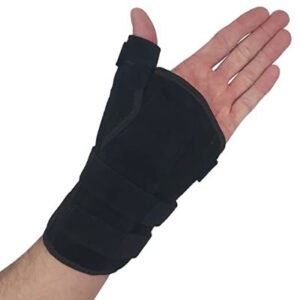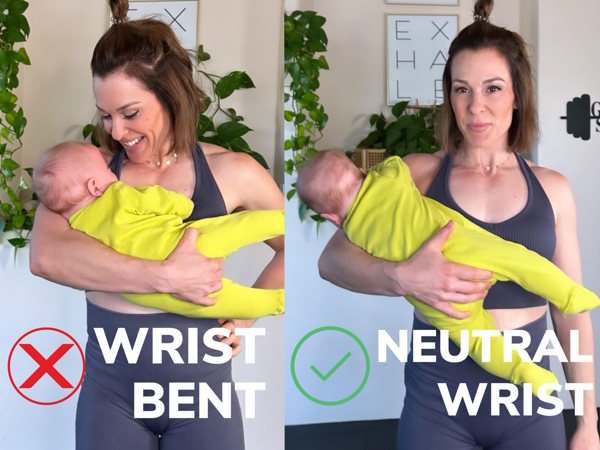You’re a new parent, and a few weeks in you start to notice pain radiating from your thumb to your wrist. It’s especially apparent as you pick up, hold or feed your baby. Called “Mommy Wrist,” this pain is often ignored as new moms try to push through it. What choice do we have when the baby is only content being held?
Let’s dive into what causes mommy wrist and how you can treat symptoms.
What is Mommy Wrist?
Mommy’s wrist is a type of tendonitis. It’s officially called de Quervain’s tenosynovitis, mommy’s thumb or baby wrist. It occurs in parents of newborn and young children from carrying, holding or feeding their baby in a way that overuses the muscles in your wrist.
The abductor pollicis longus muscle becomes painful and inflamed. This muscle controls movement and tendons in your wrists and thumb.
Most of the time, new parents will start to feel pain in the wrist or hand within the first few months of a baby’s life.
Tips for Avoiding Mommy Wrist
While not inevitable, mom wrist is very common. The best way to heal it is to let it rest. (Rest with a newborn? Right, Ashley…). You can make small changes to alleviate strain on your wrists and thumbs.
Here are some tips you can use to reduce symptoms as soon as you start to notice them, or to try to avoid it altogether.
Wear a Splint
Like all inflamed nerves and tendons, rest is the first step to healing. Wearing a wrist splint with a thumb spica gives the thumb and wrist a chance to rest as you go about most activities.
Avoiding repetitive thumb movements gives the nerves and tendons time to heal. A splint can be helpful to wear at night when you’re unaware of how your wrist is bending while sleeping.

Adjust your Hold
If you have wrist pain from holding a baby, try to keep your hand and wrist “flat.” Avoid “curling” your hand in as you pick up and hold your baby. Think of “scooping” the baby up from underneath – this will reduce stress on your thumb and wrist.
As your baby grows, the way you hold them will change. Stay aware of how you lift, hold and carry your child. Avoid awkward positions that lead to pain.

Prop the Baby During Feeding
Place a pillow underneath your baby to help raise them up as you feed (breast or bottle). The pillow takes on most of the work supporting the baby, giving your wrist and hands a break. And your neck and shoulders too – how often do we find ourselves hunching over our baby as we try to feed them?
Carpal Tunnel vs. Mommy Wrist
A related hand and wrist issue is carpal tunnel. Both cause pain and discomfort at the base of the thumb. Symptoms of carpal tunnel include numbness or tingling, due to pressure on a nerve. Tenosynovitis is an inflammation of the tendon. That’s what causes the pain, usually on the thumb side of the wrist or hand.
Thanks to fluid retention and hormonal shifts, both de Quervain’s or carpal tunnel can also occur during pregnancy. If this is you, I feel your pain! When I was pregnant with the twins, I had carpal tunnel pain so bad it would wake me up. Thankfully, pregnancy-related wrist and hand problems usually go away after childbirth.
Is it Mommy Wrist?
It’s a good idea to perform the Finkelstein test on yourself. Bend your thumb across the palm of your hand and bend your fingers down over your thumb. Then bend your wrist toward your little finger. If you feel pain on the thumb side of your wrist, you likely have mommy wrist.
Relieving Postpartum Wrist Pain
Try incorporating these tips and exercises to help relieve the pain and inflammation in your wrists. Don’t be afraid to use modifications during exercise to reduce strain on your wrists.
Roll it Out
Use a small ball, such as a lacrosse or tennis ball, to massage your hands, wrists, and up and down your forearms. Apply some pressure. This will help to release tension.
Modify Your Workout
If your workout calls for the use of a bench (or floor or wall), you can make modifications to avoid pain. This is helpful for movements that place a lot of pressure on the wrist and thumb, like push ups and planks.
Release Your Traps
Incorporate movements that help release your trapezius (upper back) muscles. Tension in your traps can work its way down your arms and into your wrists.
Mommy Wrist Treatment Options
The best treatments for mommy wrist are conservative: rest, splint and pain relief. We already covered the benefits of rest and wearing a splint. Other treatments include:
Pain Relief
Your doctor may recommend anti-inflammatory medication, like ibuprofen (Advil, Motrin). These are generally safe to take while breastfeeding, but please discuss medications with your doctor first.
If a splint or pain medication doesn’t work, a doctor may suggest corticosteroid injections.
Add Ice
Applying ice will help to reduce swelling and inflammation.
When to Call a Doctor
If you’re in significant pain or at-home treatments are not working, you may want to see a physical therapist. The therapist will review how you use your wrist and offer changes you can make to relieve stress. They can also suggest exercises to specifically help you.
Surgery is rarely necessary, although it is occasionally recommended for very serious cases.
Mommy wrist is common and not just among women. Any caregiver of young children may experience “Mommy Wrist.” With better body mechanics when you pick up, hold and nurse your baby, the pain will improve.
